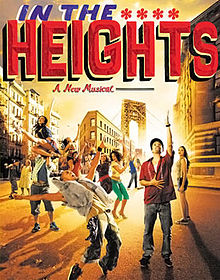Opinion by Ed Morales, CNN | From its opening sequence, Lin Manuel Miranda’s new film “In the Heights” (adapted from the stage musical of the same name) spells out its Disney-ish conceit for the audience. “Once upon a time in a far-away land called Nueva York,” his lead character Usnavi, played by Anthony Ramos, assures a group of small children seated around him at a mythical Caribbean beach. “The streets were made of music.”
From there, the audience is constantly reminded that those streets were also made of light-and-sweet coffee from uptown bodegas, a smorgasbord of Caribbean cuisine, sex-positive beauty salon gossip, and of course, hot salsa and merengue dancing. But as this extended piece of eye and ear candy unfolds, one has to wonder, haven’t we seen this before? Does representation of Latinos in the US always come down to these what might be called positive stereotypes, a kind of endless Busby Berkeley routine previously tropicalized in works like “West Side Story,” “The Mambo Kings” and “La Bamba?”
Ultimately, “In the Heights,” for all its wholesome escapism, also reveals the limits of Hollywood’s idea of representation.
With its $55 million budget, this nearly two and a half hour extravaganza has been positioned to take a lead role in American film-goers’ return to the theaters this summer. Delayed by a year because of the pandemic, and even longer than that because studios wanted big-name casting, “In the Heights” wants to shake you out of your Netflix slumber with a form of feel-good musical magic that some think is rapidly becoming obsolete.
The formula is well-executed: take one part lyricist/rapper Miranda, a helping of “Crazy Rich Asians” director Jon M. Chu, and a dash of choreographer Christopher Scott, who worked on one of the “Step Up” dance films with Chu, and you should have a massive success. This is borne out on many levels: Star turns by Anthony Ramos, Melissa Barrera (Vanessa), Leslie Grace (Nina) and Corey Hawkins (Benny) can make them more viable as bankable performers, and much of the Latino cast stands out in a moment when overall in Hollywood, actors of their background have very little visibility.
Many of the themes of Latino life in the US, such as struggles with debt, racial and ethnic discrimination and the difficulty of acculturating are put on display with competence and precision in this film. The characters’ rhyme-spitting in English, Spanish and Spanglish, a central part of the tricky task of portraying its fusion of African- and Anglo-American culture and language with home country tradition, is spot on for the most part.
The political urgency of the original Broadway production seems to have been toned down a bit, however — particularly when it comes to the gentrification that menaces urban barrios like Washington Heights. The opening sequence of the film promises a meditation on “a block that was disappearing,” and there are some allusions to demographic change in which wealthier renters, homeowners and shopkeepers push up rent prices to threaten affordability of the residents. A new dry cleaner wants to charge inflated prices, sending shock waves to eye-rolling residents, a beauty salon business is being forced to move out; an entire way of life for a long-time Latino barrio is on shaky ground.
But overall, the film focuses more on the love stories between the lead character, reluctant bodega owner Usnavi and aspiring graphic artist Vanessa, as well as the romance between Stanford undergraduate Nina, who is Puerto Rican, and taxi dispatcher Benny, who is African-American. To its credit, “In the Heights” does address some real-world social issues relevant to Washington Heights, such as the difficulty faced by urban Latinos who decide to attend elite universities. Nina expresses strong reluctance to return to Stanford in part because of micro-aggressions she receives from fellow students — on one occasion, her White roommate accuses her of stealing jewelry from her. But despite the many Dominican characters there’s little focus in the film on the Afro-Dominican world of the real Washington Heights.
Much of the action also centers around Usnavi’s bodega, the small convenience store that has become the ultimate signifier of urban authenticity — so much so that New York City Mayoral Candidate Andrew Yang posted a video professing his love for them. Its cramped spaces are the site of intimate conversations about life and awkward flirtation. Even as Usnavi approaches Vanessa, the camera lingers on a product-placement fest of ethnic staples, notably omitting Goya products, banished no doubt for their CEO’s endorsement of former President Donald Trump, occasionally interrupted by Sonny, Usnavi’s younger cousin who provides the film’s comic relief and the film’s most viable voice representing a desire for social change .
> > > > > > > >
Read the whole review here:
https://www.cnn.com/2021/06/10/opinions/in-the-heights-magic-but-missing-something-morales/index.html
CNN Editor’s note: Ed Morales (@SpanglishKid) is a journalist and lecturer at Columbia University’s Center for the Study of Ethnicity and Race and the Craig Newmark Graduate School of Journalism at CUNY. He’s the author of the book “Latinx: The New Force in American Politics and Culture.” The views expressed are his own. View more opinion articles on CNN.


